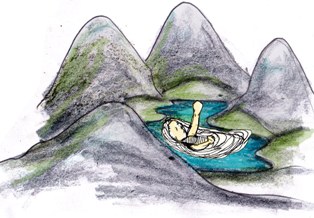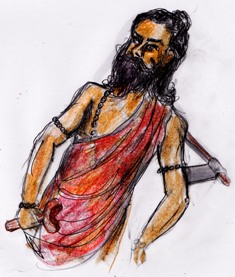Story & Trivia
This river flows through three countries – born in Tibet, flowing through India and then on to Bangladesh. It has many names - Tsangpo in Tibet, Lohit or Brahmaputra in India and Jamuna (not to be confused with Yamuna of India) in Bangladesh.
The Mystical Tsangpo
The Tibetans believe that long before human occupation, the Chang Tan plateau was covered by the waters of a great lake. A Bodhisattva (an enlightened being) decided the waters had to flow to help people who occupy the region. So he cut an outlet through the Himalayas for the Tsangpo or ‘Great River’.
the Tsangpo or ‘Great River’.
The mountains, gorges and jungles through which the Tsangpo flows in Tibet are considered extremely holy. Ancient Tibetan scrolls written by sages, speaks of sanctuaries or beyuls deep in the Himalayas. Here ageing is slowed down and, animals and plants have miraculous powers. The Tibetans believe that in this area, perhaps through one of the waterfalls at the bottom of the world’s deepest gorge, is the doorway to paradise on Earth, Shangri-la.
Son of Brahma
This river flows into India at Arunachal Pradesh and then onto Assam, where it is called the Brahmaputra. In mythological times, Amogha wife of Sage Shantanu had a child by Brahma the creator of the Universe. The child took the form of water. Shantanu placed the child right in the middle of the four great mountains – Kailash, Gandhamadana, Jarudhi and Sambwartakka. He grew into a great lake, the Brahmakunda. Parashurama an incarnation of Lord Vishnu had committed the terrible sin of killing his own mother because his father had ordered him to. So great was the sin that the axe he used got stuck in his hand!
Parashurama an incarnation of Lord Vishnu had committed the terrible sin of killing his own mother because his father had ordered him to. So great was the sin that the axe he used got stuck in his hand!
The sages advised Parashurama to visit holy places. At Brahmakunda he axed down one side of the mountains, releasing the waters to help the locals. This got the name Brahmaputra or Son of Brahma. To Parashurama’s great relief, the axe came lose and the blood from the axe got washed off, leaving a reddish tinge in the river. Hence the name Luit in Assamese (from the Sanskrit word for blood)
It is also called Burha Luit, perhaps because ‘Burha’ meaning old locally represents the ancientness of the river.
Another legend goes on to add that Parashurama used a plough to further furrow the soft soil to make a path for the waters to flow to the plains. Tired he stopped at a place near Sonargaon. Here his plough or ‘Langal’ came to a standstill or ‘bandh’, and this place got called Langalbandh. This is considered to be a very holy place to round of a pilgrimage with a dip in the Brahmaputra..
Alternatively, Balarama, Krishna’s brother committed the sin of killing many Brahmins. To wash of his sins, he went on a pilgrimage and visited the confluence of the rivers Brahmaputra and Laskshya. He used his plough to get them to flow and meet yet another river the Dhaleshwari. As this was the place where the plough stopped, it was called Langalbandh.
Interestingly, a dip here during the auspicious days is considered equivalent to a many dips in other holy places.
The Lohit or Luit or Lauhitya joins the Brahmaputra and the Brahmaputra itself is called by these names in parts of North Eastern India. From India, the Brahmaputra enters Bangladesh. In ancient times it is said, the Brahmaputra came wanting to marry Ganga. To test his love she took on the form of an old woman. When Brahmaputra came he did not recognize Ganga. She got angry and sent him off for ever. Later she allowed the Jamuna to join her.
Blood-soaked city
Tezpur in Assam is a historic town on the northern banks of Brahmaputra. Legend goes that it used to be called Sonitpur. Banasura a descendent of Prahalada, ruled here. He had a beautiful daughter Usha. Not wanting her to marry someone he did not approve off, he kept her isolated in a palace. She had among her friends the minister’s daughter Chitralekha who had some magical powers.
Usha once dreamt of a handsome young man and fell in love with him. Chitralekha helped her by drawing his image from Usha’s dreams. Then Usha helped her by identifying him as Krishna’s son Aniruddha. Later, Chitralekha carries away Aniruddha while he is sleeping at home. Once she smuggles him into Usha’s Palace, they fall in love with each other and get married.
Banasura discovers this and ties up Aniruddha in snakes. Krishna hears of this and comes to rescue him. Banasura is a great devotee of Shiva. When a huge battle begins, Shiva fights Krishna, just as many other equals fight each other. Eventually many die and the whole city is drenched in blood. Banasura’s arms are cut off and he retires to the Himalayas. Krishna returns to Dwaraka with Usha and Aniruddha.
That is how the name Tezpur comes - from ‘Teza’ + ‘Pura’ or ‘Blood’ + ‘City’.
Trivia
1. The biggest and the smallest river islands in the world, Majuli and Umandana are in the river.
2. The river is navigable for large crafts.
3. It meets with the Ganges River in Bangladesh.
4. It originates as the Yarlung Zangbo River in southwestern Tibet and is also known as the Tsangpo there.
5. The Brahmaputra is at its narrowest (1 km) at Guwahati near the ancient pilgrimage center of Hajo.
6. The Bodos, native inhabitants of Assam, a state through which the Brahmaputra flows entirely, called the river Bhullam-buthur. This means “making a gurgling sound.” The name later became the Brahmaputra.
7. The Brahmaputra is less polluted than most other rivers in India.
8. In Arunachal Pradesh, as the river enters, it is called Siang. Further in its course, it becomes known as the Dihang River.
9. The Brahmaputra’s main problem is flooding but it has pollution issues due to petroleum refining units which release industrial pollution into the waters.
10. The Brahmaputra is an important source of irrigation and navigation.